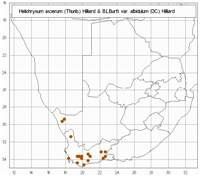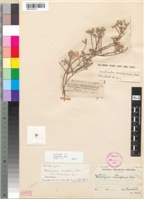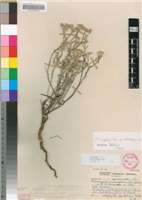Origin of name:
asper / -a / -um = rough
albidus = somewhat white, whitish
Diagnostic characters:
Very small needle-like leaves
Very small heads, solitary
Creamy bracts
Description:
Hard, stiff, divaricately branched, tangled, bushy shrublet mostly 15�400 mm tall, sometimes straggling, outer spreading branches then sending up numerous erect shoots, branches thinly grey-woolly, often glabrescent, rarely glandular-hispid, leafy. Leaves 2�6 x 0,5 mm (old primary leaves up to 20 x 1 mm), linear, acute to subacute, or obtuse, often apiculate, sessile, margins strongly revolute, both surfaces thinly white woolly-felted, leaves and young stems enveloped in tightly woven, silvery-grey, papery indumentum. Heads homogamous, c. 4 x 2 mm, cylindric, solitary or 2�4, very rarely more, together at the branch tips, closely surrounded by leaves. Involucral bracts in 5�6 series, outermost short, webbed with wool to surrounding leaves, inner subequal, equaling flowers, erect, tips semipellucid, subacute, often erose, light golden-brown with opaque white tips, often reddish below, not radiating, soon caducous. Receptacle raised, slightly tuberculate. Flowers 7�13. Achenes not seen, ovaries with myxogenic duplex hairs. Pappus bristles many, equaling corolla, scabrid, bases with patent cilia not cohering.
Flowering in December.
Distribution:
Recorded mainly from the Cape Peninsula and east through Worcester, Montagu, Bredasdorp, Riversdale and Oudtshoorn degree squares (not recorded beyond c. 23�E) with a few records from much further north, around Nababiep and Springbok in Namaqualand, and in Namibia in the diamond area (2615 DA Luderitz) and Rheinpfalz (2317 DB Rehoboth). The specimen from Rheinpfalz (Dinter 6731, BM; E; PRE; SAM) is discussed by Merxm�ller (F.S.W.A. 139: 94, 1967) under H. fleckii.
Fynbos, Nama Karoo and Succulent Karoo Biomes.
Notes:
Similar to the typical plant in habit, head size and disposition of the heads, but leaves and young stems enveloped in tightly woven, silvery-grey, papery indumentum (which may break down to wool with age) and involucral bracts with opaque white tips.
Five varieties are recognized. Not all specimens can be assigned to a variety. Putative hybrids have been reported.
la Heads mostly solitary or 2�4 at the branch tips, rarely more:
2a Tips of involucral bracts light golden-brown, often tinged red, semi-pellucid
(a) var. asperum
2b Tips of involucral bracts opaque white
(b) var. albidulum
1b Heads several at the branch tips:
3a Leaves 2�5 (�10) x 0,5 mm, glabrous
(d) var. glabrum
3b Leaves either variously woolly at least when young, or if glabrous, then leaves mostly 7�10 x 1�1,5 mm:
4a Leaves mostly 7�20 x 1�1,5 mm, woolly or glabrous; tips of involucral bracts white
(e) var. comosum
4b Leaves mostly 3�6 x 0,5�1 mm:
5a Leaves loosely woolly; involucral bracts semipellucid, buff-coloured, sometimes with a reddish tinge
(c) var. appressifolium
5b Leaves enveloped in tightly woven 'tissue-paper' indumentum (though this breaks down to wool with age); tips of involucral bracts opaque white, often reddish above the stereome
(b) var. albidulum
Taxonomy:
Literature:
Helichrysum asperum (Thunb.) Hilliard & Burtt var. albidulum (DC.) Hilliard & Burtt in Notes R. Bot. Gdn Edinb. 34: 79 (1975); Hilliard, Compositae in Natal 208 (1977).
Type:
Lectotype: Western Cape, Riversdale distr., between Soetmelks (sphalm. Troetemelks) River and Little Vette River, Burchell 6819 (G-DC; K; PRE, isolecto.).
Synonym(s):
H. ericifolium Less. var. albidulum DC., Prodr. 6: 172 (1838); Harv. in F.C. 3: 217 (1865); Levyns in Adamson & Salter, Fl. Cape Penins. 781 (1950).
Vouchers:
Esterhuysen 417 (BOL; PRE); Galpin 11322 (PRE); Schlechter 9939 (BM; PRE).

_sml.jpg)
_sml.jpg)
_sml.jpg)

